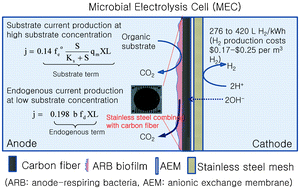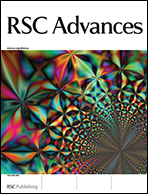Implication of endogenous decay current and quantification of soluble microbial products (SMP) in microbial electrolysis cells†
Abstract
We designed a dual-chamber microbial electrolysis cell (MEC) which provided a large anode surface area against membrane surface area, but kept a short distance between the anode and the cathode. Current density ranged from 8.3 to 11 A m−2 of membrane surface area for chemical oxygen demand (COD) loading rate 0.3–6.3 kg COD/m3 d. Hydrogen recovery (from coulombs to H2) was as high as 93 ± 25% in the MEC, and hydrogen production rate ranged from 66.4 ± 18.0 to 137.2 ± 14.4 L H2/m2 d at an applied voltage of ∼1.2 V. As a result, H2 production costs were computed at $0.17–0.25/m3 H2 ($1.7–2.6/kg H2 at 25 °C and 1 atm) in the MEC using stainless steel mesh as the cathode. The MEC designed for maintaining high concentration of anode-respiring bacteria per membrane surface area generated 8.3 A m−2 of membrane area of which 57% was produced by endogenous decay of ARB under substrate deficient conditions. Soluble microbial products (SMP) were quantified for acetate-utilizing ARB in the MEC, and SMP fraction of influent COD was 23%. We separately measured biomass-associated products and utilization-associated products of SMP experimentally, which were 286 ± 100 mg L−1 and 59 ± 30 mg COD L−1, respectively.


 Please wait while we load your content...
Please wait while we load your content...